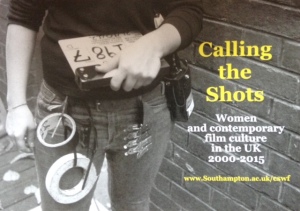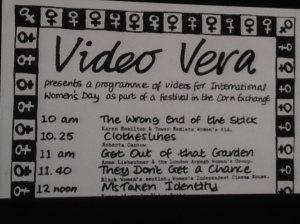Doing Women’s Film and Television Histories III: Structures of Feeling
The Third International Conference of the Women’s Film and Television History Network: UK/Ireland, 18-20 May 2016, Leicester, UK
Conference Organisers: Vicky Ball (Senior Lecturer in Cinema and Television Histories, De Montfort University), Melanie Bell (Associate Professor in Film and Media, University of Leeds), Laraine Porter (Senior Lecturer, Film Studies, De Montfort University)
This conference was organised by the Women’s Film and Television Network (UK and Ireland) [1]. The aims of the network are to research and disseminate women’s ‘participation in screen media’ and explore the roles of women in the industry, ensure ‘that women’s work is recognised in the writing of screen histories’, to ‘encourage new approaches to film and television that are sensitive to gender, class and race’ and to have ‘an impact on the teaching of screen media in schools and colleges.’ [2]
‘Structures of Feeling’, the tagline of the conference title, refers to Raymond Williams’ work [3] around the suppressed narrative; the real, lived experience which is part of culture but not recognised in the mediated history and hegemony of that culture. With presentations referring to key statistical analysis from primary research of the AHRC-funded project, ‘Calling the Shots’ [4], including the findings that ‘in 2015, women constituted just 20% of all directors, writers, producers, exec-producers, cinematographers and editors on 203 UK films in production during 2015’ , [5] the conference’s exploration and assessment of diverse narratives, histories and contributions by women in a male dominated industry was both timely and necessary. Further analysis from ‘Calling the Shots’ details that ‘74% of films with a woman director also had a woman producer’, [6] highlighting that if a woman is employed in a main role, she is likely to recruit more women to other key roles in the crew. Of those women employed in key roles, in terms of numbers of BAME women in 2015, the report found that only ‘7% of women were of Black, Asian, or Ethnic Minority identity, making BAME women less that 1.5% of all personnel’.
If one statistical pillar of the conference was the initial findings of ‘Calling the Shots’, the other was ‘Patterns of Discrimination Against Women in the Film and Television Industries’ (1975), a report commissioned by the Association of Cinematograph, Television and Allied Technicians (ACTT) Union’s Committee of Equality. The conference chose to commemorate its 40th anniversary of publication, with presentations by Frances Galt (De Montfort University, Leicester) who gave an excellent historical context to the report and Barbara Evans (York University, Toronto), an original member from the London Women’s Film Group who was key in getting ACTT to agree to the role of a paid woman researcher to conduct the research and write the report. A screening at the conference of the film, ‘The Right Place: Women in West London Film Laboratories, 1960-2000’ (Dawson, A & Holmes, SP, 2016), intriguingly uses film footage of the researcher, Sarah Benton, in a meeting with male and female workers, the union and shop stewards, discussing the place of a crèche in the workplace to allow women to continue to work, after having families. Benton meets with resistance to the idea, both from male and female workers that are present, who believe that the ills of society are down to mothers at work and therefore away from the home, who are not having an influence on their children growing up.
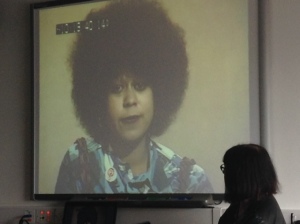
‘Open Door’ (1965) excerpt, Barbara Evans’ presentation: ‘Breaking the Pattern, The Struggle for Equality in the Film and Television Industry’
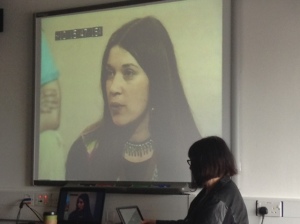
‘Open Door’ (1965) excerpt, (Barbara Evans pictured, both in film clip and in person), Barbara Evans’ presentation: ‘Breaking the Pattern, The Struggle for Equality in the Film and Television Industry’
Evans in her presentation ‘Breaking the Pattern, The Struggle for Equality in the Film and Television Industry’ outlined the situation in the workplace where women were confined to the lesser skilled roles, often secretarial, lower paid jobs, which Evans described as creating ‘sexual ghettoes’. Reasons given for women not being able to enter predominantly male domains including camera or sound work, included that the equipment was too heavy for women to carry. Evans illustrated her presentation with clips from a discussion of ACTT women activists, for BBC’s ‘Open Door’ programme in 1965, including Evans herself, to tell this story: ‘Many women were doing housework on the job… often a substitute wife or mother’ for the male bosses. The action of getting a paid female researcher was key, as many women felt intimidated to speak at union meetings or assemblies without fear of heckling. One of the ‘Open Door’ excerpts was intriguingly a satirical re-enactment of the battle between women and men around equal pay in the workplace, with women playing both gender roles. This creative approach to engaging with issues of inequality was also highlighted in Rachel Fabian’s (California) paper ‘What are We Left With?: The London Women’s Film Group and the Legacies of 1970s’ Collective Media Production’, where Fabian referred to London Women’s Film Group’s ‘The Amazing Equal Pay Show’, (1974), which was a film looking at the place of working class women in a capitalist society and worked with the Women’s Street Theatre Group, to lampoon issues of inequality through using the language of carnival, street theatre and pantomime.

Slide from Rachel Fabian’s presentation: ‘What Are We Left With? The London Women’s Film Group and Legacies of the 1970s Collective Media Production‘, featuring ‘The Amazing Equal Pay Show’ (1974), London Women’s Film Group
This is only one route through the conference, given its session structure of running up to four strands of panels to choose from. My own attendance had been thanks to association with Shona Main’s ‘Real Illuminators’ film programme, along with Dr Sarah Neely (University of Stirling), which presented eight short films [7] by early women film-makers in Scotland, predominantly in the field of documentary. Particularly resonant for this programme and area of research, was our meeting Barbara Evans, one of the first to research and write about Shetland filmmaker Jenny Gilbertson, in the Women Film Pioneers Project. Also of key interest, was the presentation by Sarah Hill (University of East Anglia), on the Women Amateur Filmmakers in Britain archive collection, digitised by East Anglian Film Archive, part of the University of East Anglia. Hill showed a selection of films from 1920s’-80s’ including animations by Sheila Graber and Joanna Fryer.

Slide from Sarah Hill’s presentation: ‘(In)visible Women? Researching Amateur Women Filmmakers’, image of ‘Make-Up’ (1978), Joanna Fryer

Slide from Sarah Hill’s presentation: ‘(In)visible Women? Researching Amateur Women Filmmakers’, image of ‘Make-Up’ (1978), Joanna Fryer
Dr Kate Dossett’s (University of Leeds) keynote, on the AHRC funded ‘Feminist Archives, Feminist Futures’, chronicled the role of the women’s library or archive from the Fawcett Library, set up by the London Society for Women’s Service in 1926, to current day archives and libraries, including reference to Glasgow Women’s Library, and a focus on Feminist Archive North, with materials on Vera Media and Leeds Animation Workshop. June Givanni also presented on her Pan African Cinema Archive collected over her 30 years working as a curator gathering film work by women directors from Africa and the diaspora. She is currently focusing on what type of an archival space architecturally can be created for this independent archive.
‘Doing Women’s Film and Television Histories III: Structures of Feeling’ conference was inspirational in its content and approach, tackling key themes from a variety of different perspectives, roles, geographies and histories. For example, the first Plenary, ‘Costume, Women, Work and History’ had a costume designer and supervisor (Lezli Everitt, Costume and Training Skills, BECTU Learning Organiser), academic (Tamar Jeffers McDonald, University of Kent) and curator (Keith Lodwick, V&A Museum) contributing, allowing the spectrum of discussion to range from the actualities of the workplace, to academic framing and then questions of exhibition. As the conference was looking at aspects of power and power holders, predominantly being ascribed in examples in favour of the male domain, a key presentation by Gina Marchetti ‘The Feminine Touch: Chinese Soft Power Politics and Hong Kong Women Filmmakers’, provided an interesting case study in the navigation of soft power by women filmmakers including Ann Hui, in securing financial backing and box office success.
The delegates and contributors were from diverse ages, points in their career and experiences which allowed for all contributions to be recognised and acknowledged as significant to the continuation of the field. And again in the sense of the ‘continuity bible’, referred to in several presentations including Lezli Everitt’s, as a trade device to track change and make note of what has occurred, the conference ephemera, notes, discussions, further reading, conversations with other delegates and presentations on key projects, will continue to have an impact on evolving lines of research investigation. It was announced that the next conference will take place at University of Southampton in 2018.
Jenny Brownrigg (May 2016)
Footnotes
[1] WFTHN is one of the results from the AHRC funded project ‘A History of Women and Work in the British Film and Television Industries 1933-1989’
[2] From delegates’ pack materials.
[3] ‘The Long Revolution’, Williams, R (1961)
[4] ‘Calling the Shots’ is led by Dr Shelley Cobb & Prof Linda Ruth Williams, University of Southamption, with partners including BFI, BECTU and Women in Film and Television UK. The project supports a Research Fellow (Dr Natalie Wreyford) with two PhD students.
[5] Ibid.
[6] Ibid.
[7] ‘Real Illuminators’ film programme, curated by Shona Main, is as follows: ‘Peat From Hillside to Home’ (1932) Jenny Gilbertson; ‘Flowers and Coffee Party at Umanak’ (1935) Isobel Wylie Hutchison; ‘Beside the Seaside’ (1935) Marion Grierson; ‘Challenge to Fascism / May Day 1938’ Helen Biggar; ‘Ceylon Calling’ (1939) Nettie McGavin; ‘They Also Serve’ (1940) Ruby Grierson; ‘A Portrait of Ga’ (1952) Margaret Tait; ‘The Aardvark or Ant Bear’ (1961) Elizabeth Balneaves.
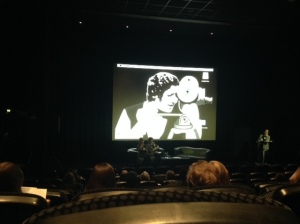
‘Real Illuminators’ logo, designer Bryn Houghton, at ‘Doing Women’s Film and Television Histories III: Structures of Feeling’ conference, Leicester, 2016
Further notes of reference from conference:
Films:
‘Nightcleaners, Part 1’, Berwick Street Film Collective (1975)
‘Prairie Women’, Barbara Evans (1987)
‘Women Amateur Filmmakers Trailer’, EAFA Amateur Film, www.vimeo.com/162349610
‘Daughters of the Dust’, Julie Dash (1991) (reference from June Givanni presentation)
‘A Dry White Season’, Euzhan Palcy (1989) (reference from June Givanni presentation)
Websites:
Women Film Pioneers Project http://wfpp.cdrs.columbia.edu (reference from Barbara Evans)
British Silent Cinema and the Transition to Sound 1927-1933 www.silenttosound.org.uk (reference from Sarah Neely)
The Boudica Film Fund www.boudicafilms.co.uk
Women On Boards 40:40:20 campaign www.womenonboards.net
Women 50:50 www.women5050.org campaign for at least 50% representation of women in parliament, councils and public boards
Books:
‘Gender meets genre in postwar cinemas’, Christine Gledhill, (2012)
‘Doing Women’s Film History: Reframing Cinemas Past and Future’, edited by Christine Glehill & Julia Knight (2015), University of Illinois Press.
‘Notes on Women’s Cinema’, edited by Claire Johnston (1973)
[Article], ‘The Amazing Equal Pay Show’, London Women’s Film Group 1974 / Publishers Spare Rib, Aug 1975.
‘Aftershocks of the New: Feminism and Film History’, Patrice Petro (2002), Rutgers University Press.
Publishers:
University of Illinois Press (reference from Professor Emiritus Michelle Hilmes), interested in women’s histories, in particular submission on women’s involvement in sound period.
Trade Union:
BECTU www.bectu.org.uk
Archives:
Film Archives UK
Institute of Amateur Cinematographers library, at East Anglian Film Archive, University of East Anglia
Other:
Beatriz Azurduy Palacios (1952-2003), Bolivian motion picture director (Isabel Segui, University of St Andrews presentation)
Elizabeth Haffenden (1906-1976), costume designer (reference from Tamar Jeffers McDonald presentation)
Beatrice ‘Bumble’ Dawson (1908-1976), costume designer (reference from Tamar Jeffers McDonald presentation)
Dr Heather Norris Nicholson, University of Huddersfield, archive film and changing amateur visual practice. (reference from Sarah Hill’s presentation)
‘Women and Film’ event, Edinburgh Festival, 1972
‘Third Eye Film Festival’ 1983 (Reference June Givanni presentation)

